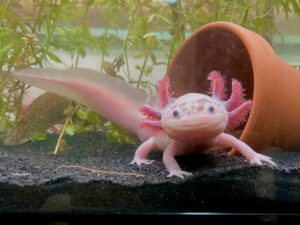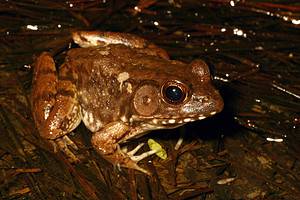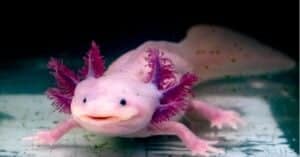When it comes to dangerous animals, crocodiles, bears, and snakes are at the top of the list. But did you know that the most poisonous animal in the world is only 2 inches long and contains enough poison to kill 10 men?! I’m referring to the golden poison dart frog — a tiny yet fierce amphibian that’s only the size of a paperclip.
Scary Skin
First discovered in 1973, the golden poison dart frog is one of the largest species of poison dart frog. But for only being the length of a sewing needle, this tiny creature packs a poisonous punch. One of these frogs contains enough poison to kill 10 men, with the lethal dose being the size of just two grains of salt.
Unlike rattlesnakes and spiders, which transmit toxin through a bite, the golden poison dart frog is much more dangerous. This frog secretes poison directly through its skin, which can enter into the bloodstream through a cut or by consumption. Since it only takes a small amount of poison to kill a man, simply touching these creatures can be lethal.
The poison is a batrachotoxin, present in only a few other organisms, like the Pitohui bird. Batrachotoxin is a cardio and neurotoxin, meaning it affects the heart and nervous system. Specifically, it opens the sodium channels of nerve cells irreversibly, which blocks nerve signals from transmitting to the muscles. This poison causes nearly instant paralysis, has no known antidote, and leads to death within 10 minutes of exposure.
Identifying Golden Poison Dart Frogs
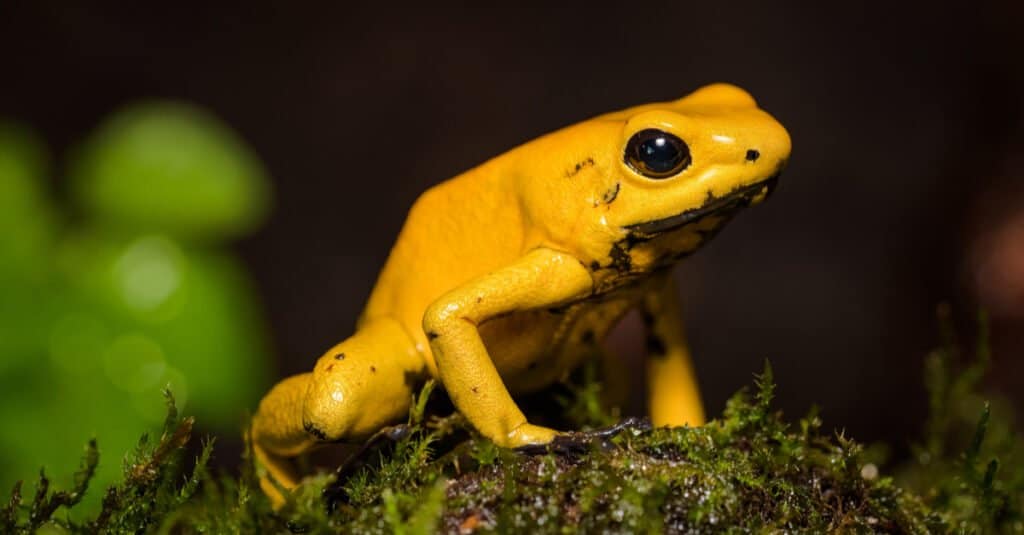
They are native to a small region of western Colombia, where they live on the ground near rivers and other waterways.
©Thorsten Spoerlein/Shutterstock.com
Now that you know how poisonous this frog is, you may be wondering how you can identify one. Golden poison dart frogs range from golden-yellow or orange in color to pale or mint green. Adolescent dart frogs are black with golden stripes across their backs. This multi-colored striped pattern transforms into a monochrome golden hue as they reach maturity.
The frogs have long, slender legs and weigh less than an ounce. They are native to a small region of western Colombia, where they live on the ground near rivers and other waterways. They are carnivores and eat insects like flies, beetles, and caterpillars. Like other frogs, they reproduce quickly and lay eggs. The eggs then turn into tadpoles, which latch onto the male frog and get carried into a nearby water source.
They have an average lifespan of six to 10 years and are currently threatened most by habitat loss. The population is currently decreasing due to the decimation of the rainforest from logging, mining, and deforestation.
The species is endangered, so there are not many golden poison dart frogs left in the region. However, there are a few rescues for these frogs, like the Rana Terribilis Amphibian Reserve, where they live abundantly in a rainforest environment similar to that of Colombia.
Hunting History
Golden poison dart frogs were used by the Emberá Chocó tribe of South American Indians. They used the poison on the tips of their blowgun darts for hunting animals and as protection against other humans.
Knowing the danger of the poison entering even a small scratch, the Indians protected their hands with leaves. With these protective measures in place, the Chocó Indians would capture these poisonous frogs and rub the tip of the darts across their backs.
One dart frog would be held down by a stick and could supply enough poison for the tips of two to three darts before being released. For a larger production of darts, the frogs would be impaled on sticks and held over a fire. In this method, the frogs produced enough poison for 20 to 30 darts! The poison was extremely lethal and lasted for up to a year on the darts.
Modern Medicine
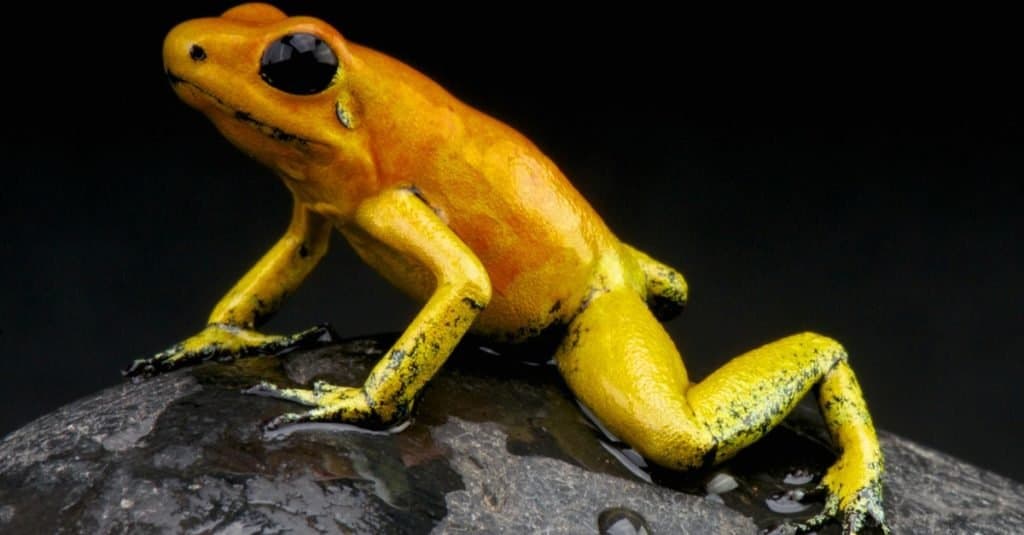
Golden poison dart frog toxin is over 200 times more potent than morphine, and chemists have already recreated the poison synthetically in a lab.
©reptiles4all/Shutterstock.com
Similar to other natural toxins and poisons, the batrachotoxin present in these frogs has been heavily researched as a possible medical compound or even a painkiller. It is over 200 times more potent than morphine, and chemists have already recreated the poison synthetically in a lab.
While it may seem counterintuitive to intentionally make this deadly poison, scientists claim it’s a great way to research how nerves conduct electricity. Batrachotoxin affects the nervous system by interrupting the electrical impulses through the nerves and muscles. Therefore, by studying the phenomenon, scientists believe it will give them a deeper understanding of the effect electrical impulses have on heart function and pain sensation. They also hope that in time, the compounds in this toxin may be altered to use as a type of painkiller.
Golden Poison Dart Frogs: A Major Danger?
You probably won’t have to worry about running into these tiny amphibians during your daily travels. Between their limited habitat and endangered status, the golden poison dart frog is a dangerous yet uncommon threat to humans. As environmental protective measures and research studies increase on golden poison dart frogs, it’s important to remember that there is still much to learn about these lethal little creatures.
The photo featured at the top of this post is © reptiles4all/Shutterstock.com
FAQs (Frequently Asked Questions)
What kind of toxin do golden poison dart frogs produce?
Golden poison dart frogs excrete batrachotoxin — a cardio and neuro-toxin that affects the heart and nervous system.
How long does fatality occur after exposure to golden poison dart frogs batrachotoxin excretions?
Just the size of two grains of salt worth of batrachotoxin in the bloodstream (through a cut or consumption) is enough to kill an adult man in 10 minutes or less.
Thank you for reading! Have some feedback for us? Contact the AZ Animals editorial team.



